最新第五章英译汉常用的方法和技巧(四)
- 格式:pdf
- 大小:16.51 KB
- 文档页数:5
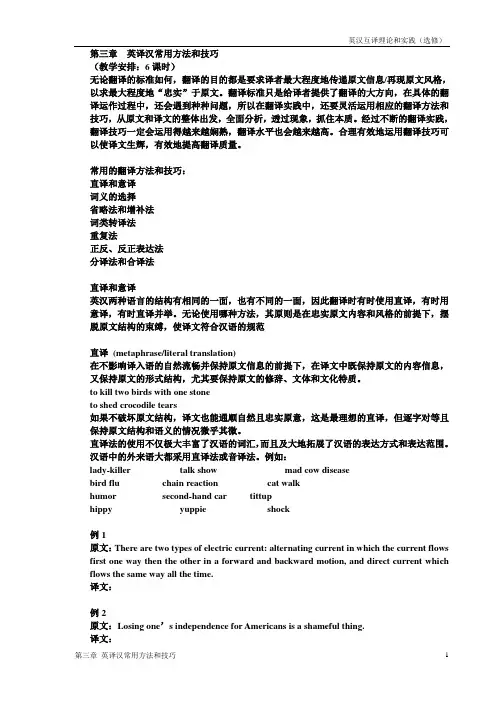
第三章英译汉常用方法和技巧(教学安排:6课时)无论翻译的标准如何,翻译的目的都是要求译者最大程度地传递原文信息/再现原文风格,以求最大程度地“忠实”于原文。
翻译标准只是给译者提供了翻译的大方向,在具体的翻译运作过程中,还会遇到种种问题,所以在翻译实践中,还要灵活运用相应的翻译方法和技巧,从原文和译文的整体出发,全面分析,透过现象,抓住本质。
经过不断的翻译实践,翻译技巧一定会运用得越来越娴熟,翻译水平也会越来越高。
合理有效地运用翻译技巧可以使译文生辉,有效地提高翻译质量。
常用的翻译方法和技巧:直译和意译词义的选择省略法和增补法词类转译法重复法正反、反正表达法分译法和合译法直译和意译英汉两种语言的结构有相同的一面,也有不同的一面,因此翻译时有时使用直译,有时用意译,有时直译并举。
无论使用哪种方法,其原则是在忠实原文内容和风格的前提下,摆脱原文结构的束缚,使译文符合汉语的规范直译(metaphrase/literal translation)在不影响译入语的自然流畅并保持原文信息的前提下,在译文中既保持原文的内容信息,又保持原文的形式结构,尤其要保持原文的修辞、文体和文化特质。
to kill two birds with one stoneto shed crocodile tears如果不破坏原文结构,译文也能通顺自然且忠实原意,这是最理想的直译,但逐字对等且保持原文结构和语义的情况微乎其微。
直译法的使用不仅极大丰富了汉语的词汇,而且及大地拓展了汉语的表达方式和表达范围。
汉语中的外来语大都采用直译法或音译法。
例如:lady-killer talk show mad cow diseasebird flu chain reaction cat walkhumor second-hand car tittuphippy yuppie shock例1原文:There are two types of electric current: alternating current in which the current flows first one way then the other in a forward and backward motion, and direct current which flows the same way all the time.译文:例2原文:Losing one’s independence for Americans is a shameful thing.例3原文:Italian gourmets are protesting against the invasion of foreign foods on the dinner table.译文:例4原文:In short, when employees leave their performance reviews, they should be focusing on what they can do better in the year ahead, not worrying about what went into their files about the past.译文:例5原文:But when I look at the Third World and think “What can I do to solve this?”, my reaction isn’t to say “Let’s bring population down immediately”.译文:例6原句:Hitler was armed to the teeth when he launched the Second World War, but in a few years, he was completely defeated.译文:例7原文:People are always talking about “the problem of yo uth.” I f there is one, then it is older people who create it, not the young people themselves. Let us get down to fundamentals and agree that the young are after all human beings—people just like their elders. There is only one difference between an old man and a young one: the young man has a glorious future before him and the old one has a splendid future behind him, and maybe that is where the rub is.译文:直译不等于死译、硬译,直译也需要灵活变通,不能只求形式对等而破坏原文内容。

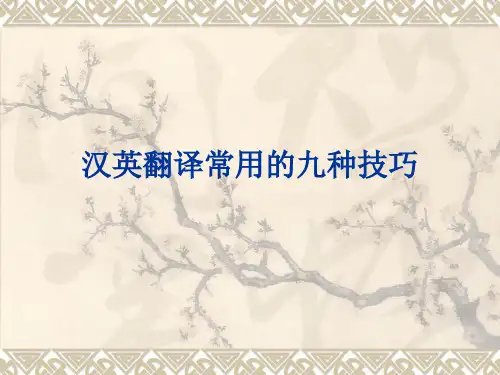
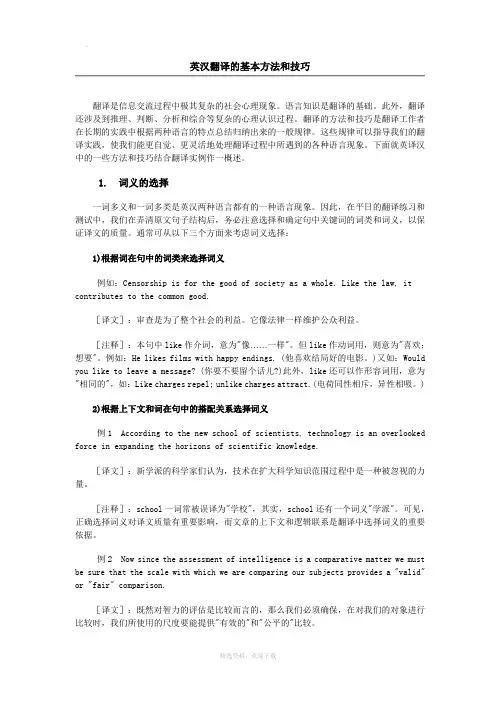
英汉翻译的基本方法和技巧翻译是信息交流过程中极其复杂的社会心理现象。
语言知识是翻译的基础。
此外,翻译还涉及到推理、判断、分析和综合等复杂的心理认识过程。
翻译的方法和技巧是翻译工作者在长期的实践中根据两种语言的特点总结归纳出来的一般规律。
这些规律可以指导我们的翻译实践,使我们能更自觉、更灵活地处理翻译过程中所遇到的各种语言现象。
下面就英译汉中的一些方法和技巧结合翻译实例作一概述。
1.词义的选择一词多义和一词多类是英汉两种语言都有的一种语言现象。
因此,在平日的翻译练习和测试中,我们在弄清原文句子结构后,务必注意选择和确定句中关键词的词类和词义,以保证译文的质量。
通常可从以下三个方面来考虑词义选择:1)根据词在句中的词类来选择词义例如:Censorship is for the good of society as a whole. Like the law, it contributes to the common good.[译文]:审查是为了整个社会的利益。
它像法律一样维护公众利益。
[注释]:本句中like作介词,意为"像……一样"。
但like作动词用,则意为"喜欢;想要"。
例如:He likes films with happy endings. (他喜欢结局好的电影。
)又如:Would you like to leave a message? (你要不要留个话儿?)此外,like还可以作形容词用,意为"相同的",如:Like charges repel; unlike charges attract.(电荷同性相斥,异性相吸。
)2)根据上下文和词在句中的搭配关系选择词义例1According to the new school of scientists, technology is an overlooked force in expanding the horizons of scientific knowledge.[译文]:新学派的科学家们认为,技术在扩大科学知识范围过程中是一种被忽视的力量。
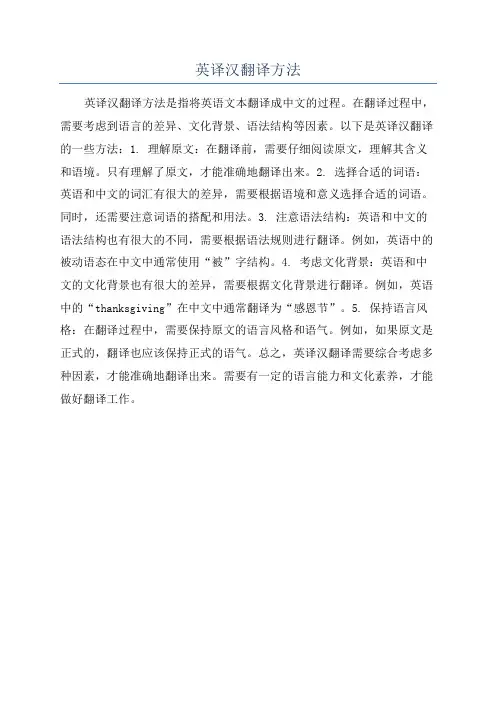
英译汉翻译方法
英译汉翻译方法是指将英语文本翻译成中文的过程。
在翻译过程中,需要考虑到语言的差异、文化背景、语法结构等因素。
以下是英译汉翻译的一些方法:1. 理解原文:在翻译前,需要仔细阅读原文,理解其含义和语境。
只有理解了原文,才能准确地翻译出来。
2. 选择合适的词语:英语和中文的词汇有很大的差异,需要根据语境和意义选择合适的词语。
同时,还需要注意词语的搭配和用法。
3. 注意语法结构:英语和中文的语法结构也有很大的不同,需要根据语法规则进行翻译。
例如,英语中的被动语态在中文中通常使用“被”字结构。
4. 考虑文化背景:英语和中文的文化背景也有很大的差异,需要根据文化背景进行翻译。
例如,英语中的“thanksgiving”在中文中通常翻译为“感恩节”。
5. 保持语言风格:在翻译过程中,需要保持原文的语言风格和语气。
例如,如果原文是正式的,翻译也应该保持正式的语气。
总之,英译汉翻译需要综合考虑多种因素,才能准确地翻译出来。
需要有一定的语言能力和文化素养,才能做好翻译工作。
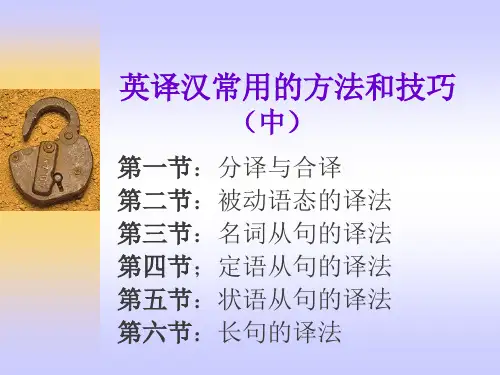
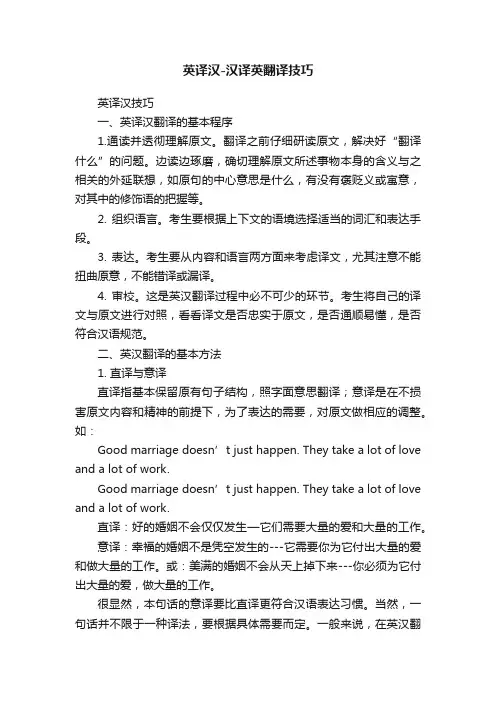
英译汉-汉译英翻译技巧英译汉技巧一、英译汉翻译的基本程序1.通读并透彻理解原文。
翻译之前仔细研读原文,解决好“翻译什么”的问题。
边读边琢磨,确切理解原文所述事物本身的含义与之相关的外延联想,如原句的中心意思是什么,有没有褒贬义或寓意,对其中的修饰语的把握等。
2. 组织语言。
考生要根据上下文的语境选择适当的词汇和表达手段。
3. 表达。
考生要从内容和语言两方面来考虑译文,尤其注意不能扭曲原意,不能错译或漏译。
4. 审校。
这是英汉翻译过程中必不可少的环节。
考生将自己的译文与原文进行对照,看看译文是否忠实于原文,是否通顺易懂,是否符合汉语规范。
二、英汉翻译的基本方法1. 直译与意译直译指基本保留原有句子结构,照字面意思翻译;意译是在不损害原文内容和精神的前提下,为了表达的需要,对原文做相应的调整。
如:Good marriage doesn’t just happen. They take a lot of love and a lot of work.Good marriage doesn’t just happen. They take a lot of love and a lot of work.直译:好的婚姻不会仅仅发生—它们需要大量的爱和大量的工作。
意译:幸福的婚姻不是凭空发生的---它需要你为它付出大量的爱和做大量的工作。
或:美满的婚姻不会从天上掉下来---你必须为它付出大量的爱,做大量的工作。
很显然,本句话的意译要比直译更符合汉语表达习惯。
当然,一句话并不限于一种译法,要根据具体需要而定。
一般来说,在英汉翻译考试中,如果直译能达意就用直译,如果直译效果不好,就应该考虑意译。
只要译文内容忠实,意思明白就行了。
2. 顺译法(又名句型对应法)顾名思义,顺译法(句型对应法)就是按原文句子结构的排列顺序进行翻译,这种译法适合于原文叙述层次与汉语相近的长句翻译,如只含名词性从句的复合句、前置的状语从句或从句在后的长复合句等等。
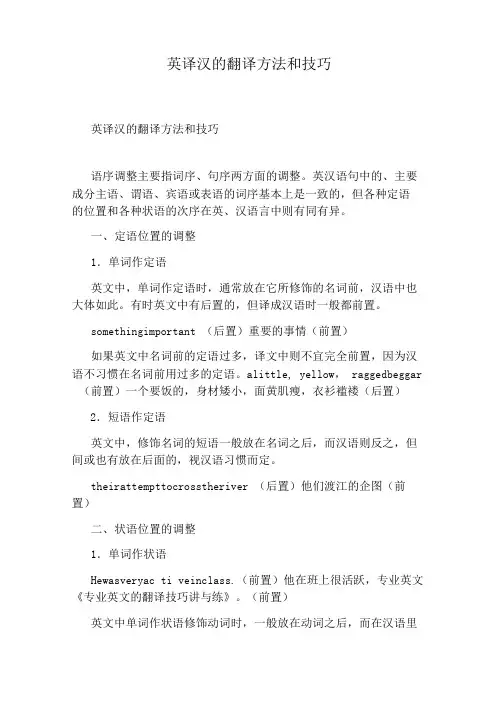
英译汉的翻译方法和技巧英译汉的翻译方法和技巧语序调整主要指词序、句序两方面的调整。
英汉语句中的、主要成分主语、谓语、宾语或表语的词序基本上是一致的,但各种定语的位置和各种状语的次序在英、汉语言中则有同有异。
一、定语位置的调整1.单词作定语英文中,单词作定语时,通常放在它所修饰的名词前,汉语中也大体如此。
有时英文中有后置的,但译成汉语时一般都前置。
somethingimportant (后置)重要的事情(前置)如果英文中名词前的定语过多,译文中则不宜完全前置,因为汉语不习惯在名词前用过多的定语。
alittle, yellow, raggedbeggar (前置)一个要饭的,身材矮小,面黄肌瘦,衣衫褴褛(后置)2.短语作定语英文中,修饰名词的短语一般放在名词之后,而汉语则反之,但间或也有放在后面的,视汉语习惯而定。
theirattempttocrosstheriver (后置)他们渡江的企图(前置)二、状语位置的调整1.单词作状语Hewasveryac ti veinclass.(前置)他在班上很活跃,专业英文《专业英文的翻译技巧讲与练》。
(前置)英文中单词作状语修饰动词时,一般放在动词之后,而在汉语里则放在动词之前。
Modernscienceand technologyaredevelopingrapidly.(后置)现代科学技术正在迅速发展。
(前置)2.短语作状语英文中短语状语可放在被修饰的动词之前或之后,译成汉语时则大多数放在被修饰的动词之前,但也有放在后面的。
Seeing this, someofusbecameveryworried. (前置)看到这种情况,我们有些人心里很着急。
(前置)Ajeepfullspedfast, drenchingmeinspray.(后置)一辆坐满人的吉普车急驶而过,溅了我一身水。
(后置)英文中地点状语一般在时间状语之前,而汉语中时间状语则往往放在地点状语之前。
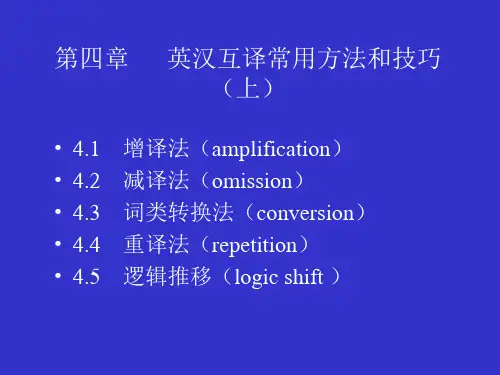
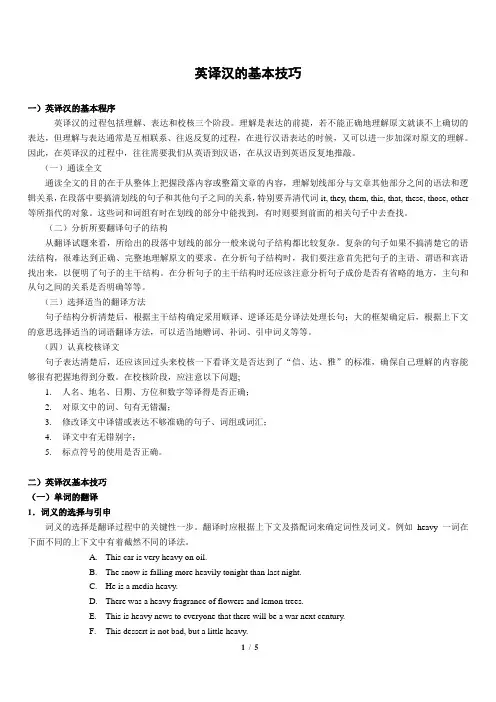
英译汉的基本技巧一)英译汉的基本程序英译汉的过程包括理解、表达和校核三个阶段。
理解是表达的前提,若不能正确地理解原文就谈不上确切的表达,但理解与表达通常是互相联系、往返反复的过程,在进行汉语表达的时候,又可以进一步加深对原文的理解。
因此,在英译汉的过程中,往往需要我们从英语到汉语,在从汉语到英语反复地推敲。
(一)通读全文通读全文的目的在于从整体上把握段落内容或整篇文章的内容,理解划线部分与文章其他部分之间的语法和逻辑关系,在段落中要搞清划线的句子和其他句子之间的关系,特别要弄清代词it, they, them, this, that, these, those, other 等所指代的对象。
这些词和词组有时在划线的部分中能找到,有时则要到前面的相关句子中去查找。
(二)分析所要翻译句子的结构从翻译试题来看,所给出的段落中划线的部分一般来说句子结构都比较复杂。
复杂的句子如果不搞清楚它的语法结构,很难达到正确、完整地理解原文的要求。
在分析句子结构时,我们要注意首先把句子的主语、谓语和宾语找出来,以便明了句子的主干结构。
在分析句子的主干结构时还应该注意分析句子成份是否有省略的地方,主句和从句之间的关系是否明确等等。
(三)选择适当的翻译方法句子结构分析清楚后,根据主干结构确定采用顺译、逆译还是分译法处理长句;大的框架确定后,根据上下文的意思选择适当的词语翻译方法,可以适当地赠词、补词、引申词义等等。
(四)认真校核译文句子表达清楚后,还应该回过头来校核一下看译文是否达到了“信、达、雅”的标准,确保自己理解的内容能够很有把握地得到分数。
在校核阶段,应注意以下问题;1.人名、地名、日期、方位和数字等译得是否正确;2.对原文中的词、句有无错漏;3.修改译文中译错或表达不够准确的句子、词组或词汇;4.译文中有无错别字;5.标点符号的使用是否正确。
二)英译汉基本技巧(一)单词的翻译1.词义的选择与引申词义的选择是翻译过程中的关键性一步。
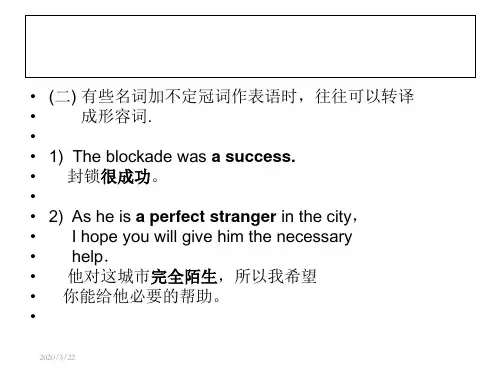
英译汉常用的方法技巧英译汉常用的方法技巧在英译汉的过程中,有哪些好的方法与技巧呢?下面就和店铺一起来看看吧!一、一词多义(Polysemy)regularregular reading / regular job / regular flight / regular visitor / regular speed / regular army / gasolinedelicatedelicate skin / porcelain / upbringing / living / health / stomach / vase / diplomatic question / difference / surgical operation / ear for music / sense of smell / touch / food二、注意有线词的词义He once again imparted to us his great knowledge, experience and wisdom.He now saw plainly the meaning of all. In the beginning, he had got a job the first day; but now he was second-hand, a damaged article, and they did not want him. They had got the best out of him, and now they had thrown him away. The situation had now become desperate. Then came another incident.三、词义的引申(Extension or Generalization)1) Extend the word meaning to cover an abstraction conceptHis novel is a mirror of the times.The OED is the final court of appeal in all matters concerning English words.Sam knows he can depend on his family, rain or shine.2) Extend the word meaning to cover a specific conceptIn two years, he was a national phenomenon.Public opinion is demanding more and more that something be done about noise.Mary’s father, by his first marriage, had a daughter, Jane, Mary’s half-sister.四、词义的褒贬(Commendatory and Derogatory)The reckless driver died in the traffic accident.Poor Joe’s panic lasted for two or three days; during which he did not visit the house.It was time to hold a court and the subject for discussion was the future of that prisoner.John was an aggressive salesman who did his job quite well.The invaders met a stubborn resistance from the local people.She was vexed by the persistent ringing of the phone.ExercisesI have no opinion of that sort of man.She put five dollars into my hand. “You have been a great man today.”I’m afraid you’re being too particular about your food.I was the youngest son, and the youngest but two.The picture flattered her.The country not agreeing with her, she returned to England.五、转译成动词(一)名词转译动词(Convert nouns into verbs)My admiration for him grew more.He said he did not know whether Tom was ready for a showdown.To some extent it gets into the question of the chicken or the egg.The Nobel prizes in physics and chemistry were rewarded to Americans, giving the U.S. a clean sweep of all the 1976 Nobelprizes in the sciences.Television is the transmission and reception of image of moving objects by radio waves.In the absence of friction, the vehicle could not even be started.Vietnamese War is a drain on American resources.I am no drinker, nor smoker.The application of electronic computers makes a tremendous rise in labor productivity.(二)介词转译成动词(Convert prepositions into verbs)There are many substances through which electric currents will not flow at all.We are fortunate in our opponent.Captain Ford was between the sheets by 9 last night.The most he is after at this time is a chance to get more money.I tried to talk him out of the idea, but he was unpleasant.Millions of the people in the mountainous areas are finally off poverty.“Coming!” Away she skimmed over the lawn, up the path, up the steps, across the veranda, and into the porch.(三)形容词转译成动词(Convert adjectives into verbs)He said the meeting was informative.They were news-hungry.It was a very informative meeting.(四)副词转译成动词(Convert adverbs into verbs)The experiment in chemistry was ten minutes behind.It has snowed over.Why should we let in foreign goods when Americans walk the streets because they can’t sell their own goods?六、转译成名词(一)动词转译成名词(Convert verbs into nouns)She knows what’s what.They thought differently.TV differs from radio in that it sends and receives pictures.The computer is chiefly characterized by its accurate and rapid computations.He roared, which threatened his enemies away.The man I saw at the party looked and talked like an American.(二)形容词转译成名词The new treaty would be good for ten years.The language of the poem is colloquial, yet it’s deep in its understanding of human emotions.Then the monkeys were trained according to different plans so as to make them highly individualized.Everyday experience shows us that heavy objects are more stable than light ones.七、转译成形容词名词转译成形容词Their physical experiment was a success.The nuclear power system designed in China is of great precision.Said a New York bullion trader, “The market’s gone banana.”He found on this issue, as on Taiwan, an identity of approach.In Europe, his name was well known, if not a household word.八、其他词类转译副词转译成名词The air-conditioning unit is shown schematically on Page 2.Oxygen is one of the important elements in the physical world, it is very active chemically.The image must be dimensionally correct.九、大量的英语被动句要化成汉语的主动句1. He said the pact had now been reduced to less than a shadow.2. She had no knowledge of this and had not been consulted on these reported plans.3. What has just been written runs the risk of oversimplification.4. Many voices have been raised demanding the setting up of an Arab common market.十、以by为着眼点,进行多种译文1. But real influence is not built up by striking attitude or by throwing insults.2. Its sincerity is illustrated not only by its proposal but also by its deeds.3. What I like best are the stern cliffs, with ranges of mountains soaring behind them, full of possibilities, peaks to be scaled only by the most daring.4. Many expect that he will be outed by one of his rivals.5. He said he was assured by the State Department that the U.S. is willing to normalize relations with his country.十一、“it + be + p.p. + that clause”的句型,常以下列形式表达1. It should be noted that he and she were academically more than just friends.2. It should be understood that to err is human.十二、汉译中需用被动式时,也最好多找一些字眼来取代“被”字1. The visitor was flattered and impressed.2. Everybody was fed up with her gossip.3. He was set upon by two naked men.4. If the expenditure is really necessary, the money can be found somehow.5. He was released immediately after Batista fled Cuba.十三、名词、动名词前增补动词1. We often go to the school-run factory for labor.2. Testing is a complicated problem and long experience is required for its mastery.十四、英语抽象名词的翻译1. He was still reluctant to talk substance.2. Many changes take place during the transformation.3. Her indifference kept all the visitors away from the exhibition hall.4. From the evaporation of water people know that liquid can turn into gases under certain conditions.十五、将具体形象的词译成该形象所具有的属性和特征,这是一种引申,需增词1. It was a Godsend to him.2. If you dare to play the fox with me, I’ll shoot you at once.十六、增添“概括”性的词1. He had slept there before, in July and again in October.2. Their host carved, poured, served, cut bread, talked, laughed, proposed health.3. The government is doing its best to ease the tension in that area.4. Proteins are composed of carbon, hydrogen, oxygen and nitrogen.5. This report summed up the achievements in technologyand education.十七、英文中为避免重复而省略之词,汉译时需补上,作必要的重复1. I hope that the meeting will not be too long, for it will only waste time.十八、汉译文根据原文意思增加一些必要的解释性文字1. And he launched into a speech, eloquently advocating his university of the future.2. Those were the words that were to make the world blossom for, “like Aaron’s rod, with flowers”.十九、增补量词1. Repeat the experiment using a wooden ruler, a piece of glass, a metal spoon, a coin, a piece of paper, a pin, a plastic comb,a key, a pencil, a tin lid and a rubber eraser.2. On April 24th 1970, China successfully launched its first man-made earth satellite.二十、增补表示复数含义的词1. But that the old workers helped us, we should have failed.2. The moving parts of a machine are often oiled so that friction may be greatly reduced.。
第三章英译汉常用方法和技巧(教学安排:6课时)无论翻译的标准如何,翻译的目的都是要求译者最大程度地传递原文信息/再现原文风格,以求最大程度地“忠实”于原文。
翻译标准只是给译者提供了翻译的大方向,在具体的翻译运作过程中,还会遇到种种问题,所以在翻译实践中,还要灵活运用相应的翻译方法和技巧,从原文和译文的整体出发,全面分析,透过现象,抓住本质。
经过不断的翻译实践,翻译技巧一定会运用得越来越娴熟,翻译水平也会越来越高。
合理有效地运用翻译技巧可以使译文生辉,有效地提高翻译质量。
常用的翻译方法和技巧:直译和意译词义的选择省略法和增补法词类转译法重复法正反、反正表达法分译法和合译法直译和意译英汉两种语言的结构有相同的一面,也有不同的一面,因此翻译时有时使用直译,有时用意译,有时直译并举。
无论使用哪种方法,其原则是在忠实原文内容和风格的前提下,摆脱原文结构的束缚,使译文符合汉语的规范直译(metaphrase/literal translation)在不影响译入语的自然流畅并保持原文信息的前提下,在译文中既保持原文的内容信息,又保持原文的形式结构,尤其要保持原文的修辞、文体和文化特质。
to kill two birds with one stoneto shed crocodile tears如果不破坏原文结构,译文也能通顺自然且忠实原意,这是最理想的直译,但逐字对等且保持原文结构和语义的情况微乎其微。
直译法的使用不仅极大丰富了汉语的词汇,而且及大地拓展了汉语的表达方式和表达范围。
汉语中的外来语大都采用直译法或音译法。
例如:lady-killer talk show mad cow diseasebird flu chain reaction cat walkhumor second-hand car tittuphippy yuppie shock例1原文:There are two types of electric current: alternating current in which the current flows first one way then the other in a forward and backward motion, and direct current which flows the same way all the time.译文:例2原文:Losing one’s independence for Americans is a shameful thing.例3原文:Italian gourmets are protesting against the invasion of foreign foods on the dinner table.译文:例4原文:In short, when employees leave their performance reviews, they should be focusing on what they can do better in the year ahead, not worrying about what went into their files about the past.译文:例5原文:But when I look at the Third World and think “What can I do to solve this?”, my reaction isn’t to say “Let’s bring population down immediately”.译文:例6原句:Hitler was armed to the teeth when he launched the Second World War, but in a few years, he was completely defeated.译文:例7原文:People are always talking about “the problem of yo uth.” I f there is one, then it is older people who create it, not the young people themselves. Let us get down to fundamentals and agree that the young are after all human beings—people just like their elders. There is only one difference between an old man and a young one: the young man has a glorious future before him and the old one has a splendid future behind him, and maybe that is where the rub is.译文:直译不等于死译、硬译,直译也需要灵活变通,不能只求形式对等而破坏原文内容。
常用英汉翻译技巧常用英汉翻译技巧来源:英汉两种语言在句法、词汇、修辞等方面均存在着很大的差异,因此在进行英汉互译时必然会遇到很多困难,需要有一定的翻译技巧作指导。
常用的翻译技巧有增译法、省译法、转换法、拆句法、合并法、正译法、反译法、倒置法、包孕法、插入法、重组法和综合法等。
这些技巧不但可以运用于笔译之中,也可以运用于口译过程中,而且应该用得更加熟练,因为口译工作的特点决定了译员没有更多的时间进行思考。
1增译法:指根据英汉两种语言不同的思维方式、语言习惯和表达方式,在翻译时增添一些词、短句或句子,以便更准确地表达出原文所包含的意义。
这种方式多半用在汉译英里。
汉语无主句较多,而英语句子一般都要有主语,所以在翻译汉语无主句的时候,除了少数可用英语无主句、被动语态或"There be…"结构来翻译以外,一般都要根据语境补出主语,使句子完整。
英汉两种语言在名词、代词、连词、介词和冠词的使用方法上也存在很大差别。
英语中代词使用频率较高,凡说到人的器官和归某人所有的或与某人有关的事物时,必须在前面加上物主代词。
因此,在汉译英时需要增补物主代词,而在英译汉时又需要根据情况适当地删减。
英语词与词、词组与词组以及句子与句子的逻辑关系一般用连词来表示,而汉语则往往通过上下文和语序来表示这种关系。
因此,在汉译英时常常需要增补连词。
英语句子离不开介词和冠词。
另外,在汉译英时还要注意增补一些原文中暗含而没有明言的词语和一些概括性、注释性的词语,以确保译文意思的完整。
总之,通过增译,一是保证译文语法结构的完整,二是保证译文意思的明确。
如:(1)What about calling him right away?马上给他打个电话,你觉得如何?(增译主语和谓语)(2)If only I could see the realization of the four modernizations.要是我能看到四个现代化实现该有多好啊!(增译主句)(3) Indeed, the reverse is true实际情况恰好相反。
第五章英译汉常用的方法和技巧(中)(二)第四节定语从句的译法/第五节状语从句的译法一、定语从句的译法从句可以分为限制性定语从句和非限制性定语从句两种,两类定语从句在翻译方法上基本类似, 因此我们把它们放在一起介绍。
在翻译定语从句时,我们经常采用下列的翻译方法: 1. 前置法把英语原文的定语从句翻译成带“的”的定语词组, 放置于被修饰的词之前, 将英语原文的复合句翻译成汉语的简单句, 这种方法一般用于限制性定语从句比较短的情况。
一些较短的具有描述性的非限制性定语从句也可采用前置法, 但没有限制性定语从句使用得普遍。
例如:例1.For example, one function of friendship seems to fulfill is that it supportsthe image we have of ourselves, and confirms the value of the attitudes we hold.例如, 友谊的一个作用似乎是支持我们在自己心目中的形象, 并使我们持有的价值观念更加坚定。
例2.The first two must be equal for all who are being compared, if any comparisonin terms of intelligence is to be made. 如果要从智力方面进行任何比较的话, 那么对所有被比较者来说, 前两个因素必须是一样的。
例3.The first method is to give a synonym, a word that has nearly the same meaning as the word you wish to define: face for countenance, nervousness for anxiety.第一种方法是同义词法, 即给出一个与要释义的词在意义上几乎相同的, 如用face表示countenance, 用nervousness表示anxiety.例4.Behaviourists, in contrast, say that difference in scores are due to the factthat blacks are often deprived of many of the educational and other environmentaladvantages that whites enjoy.相反, 行为主义者认为, 成绩的差异是由于黑人常常被剥夺了白人在教育及其他外界环境方面所享有的许多有利条件而造成的。
例5.The method of scientific investigation is nothing but the expression of thenecessary mode of working of the human mind; it is simply the mode by which allphenomena are reasoned about and given precise and exact explanations. 科学研究的方法不过是人类思维活动的必要表达方式, 也就是对一切现象进行思考并给以精确而严谨解释的表达方式。
例6.A youngster who has no playmates of his age living nearby may benefit greatlyfrom attending nursery school.附近没有同龄伙伴和自己玩的儿童,上托儿所可以得到很多的益处。
2. 后置法当定语从句较长时,如果翻译成前置的定语,就会不符合汉语的表达习惯,在这种情况下,往往把该定语从句翻译成并列的分句,放置于原来它所修词的后面。
另外在处理此类定语从句时,一般遵循的原则是:若保留先行词,则在第二个分句中加以重复,若省略,则两个并列分句中均不再保留。
当然,在实№的翻译过程中也有例外。
例1.All the water that flows through the wide pipe in a second must somehow getthrough a narrow part too, which it can do only by going faster.在一秒钟内流过粗管子的全部水量,一定会以某种方式通过细管子,这只有靠加快流速才能做到。
例2.Perhaps light is some sort of electric wave, whose nature we do not yetunderstand.也许,光是某种电波,其性质我们尚不清楚。
例3.They are striving for the ideal which is close to the heart of every Chineseand for which, in the past, many Chinese have laid down their lives.他们正在为实现一个理想而努力, 这个理想是每个中国人所珍爱的, 在过去,许多中国人曾为了这个理想而牺牲了自己的生命。
例4.This will be particularly true since energy pinch will make it difficult tocontinue agriculture in high-energy American fashion that makes it possible tocombine few farmers with high yields. 这种困境将是确定无疑的,因为能源的匮乏使农业无法以高能量消耗这种美国耕种方法继续下去了,而这种耕种方式使投入少数农民就可获得高产成为可能。
例5.“In short”, a leader of the new school attends, “the scientific revolution,as we call it, was largely the improvement and invention and use of a series ofinstruments that expanded the reach of science in innumerable directions.”新学派的一位领袖人物坚持说:“简而言之,我们所称谓的科学革命,主要指一系列器具的改进、发明和使用,这些改进、发明和使用使科学发展的范围无所不及。
例6.The food supply will not increase nearly enough to match this, which means that we are heading into a crisis in the matter of producing and marketing food. 食品的供应将赶不上人口的增长, 这就意味著我们在粮食的生产和购销方面正陷入危机。
二、状语从句的译法状语从句内容丰富,涉及面广,可以用来表示时间、原因、条件、让步、目的、结果、等意义。
英语状语从句的翻译,一般比较容易处理,通常可以直接翻译。
但是这里我们所要讨论的是,在汉语译文中,要如何将状语从句置于恰当的位置,并如何将其与主句之间自然连贯地连接起来,如何按汉语的习惯表达将句子类型进行相应的变化。
由于两种语言表达上的不同,在状语从句的安排方面,存在着明显的差异,所以在翻译的时候也需要根据汉语习惯来灵活翻译。
时间状语从句在英语中,时间状语从句的连接词常常有:when(当...的时候),whenever(每当...),as(当...时), since(自从...),until(直到...,如果不....),till(直到...),before(在...前),after(在...后),as soon as(一...就),once(一旦...),the moment(一...就),immediately(一...就),the day(在...那天),no sooner... than (一...就),hardly(scarcely)... when(一...就),the instant(一...就),instantly (一...就),directly(一...就),the minute(一...就),the second(一...就),every time(每当...),by the time(等到....的时候)等。
翻译的时候,一般翻译在主句的前面。
(一)译成相应的时间状语While she spoke, the tears were running down.她说话时,泪水直流。
She came in when I was having supper.我正在吃饭的时候,她进来了。
As he finished the speech, the audience burst into applause.他结束讲话的时候,听众掌声雷动。
(二)译成“一(刚、每)...就”的结构I’ll let you know as soon as I have it arranged.我一安排好就通知你。
Directly he uttered these words there was a dead silence.他刚说出这些话,大家就沉默下来。
(三)译成条件句由于时间状语的引导词除了显示时间关系之外,有时候可以表示条件关系,所以还可以翻译为条件句。
Turn off the switch when anything goes wrong with the machine.如果机器发生故障,就把电门关上。
A body at rest will not move till a force is exerted on it.若无外力的作用,静止的物体不会移动。
We can't start the job until we have the approval from the authority concerned.如果没有有关当局的批准,我们不能开始这项工作。
原因状语从句英语中,原因状语从句的连接词常常是:because(因为),since(既然,由于),as(因为),now that(既然),seeing that(既然),considering that(考虑到,因为),in that(在某方面),in view of the fact that(鉴于)。